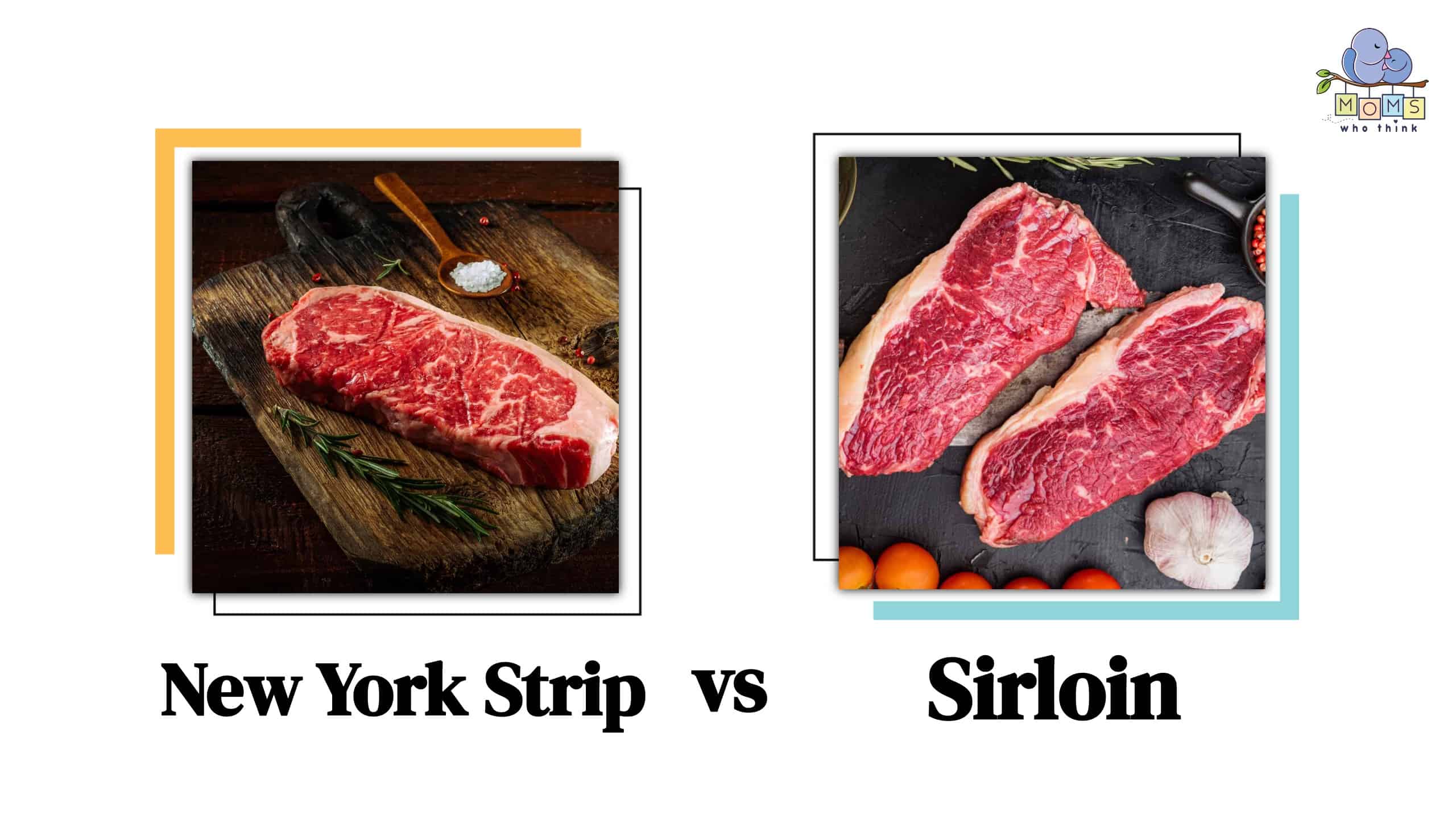Sitting down to a juicy, tender steak that hits your taste buds just right is a fabulous way to spend your dinner, especially if you are a steak lover. However, even if you love steak, you may still have some questions, like what are the differences between a New York strip and a sirloin? Are all steaks the same, or are there differences? The truth is not all cuts of meat are equal. Personal preference is a factor in choosing which steak you prefer. Both New York strip and sirloin are delicious steaks, but they have some differences. This post will examine the differences and which steak is best.
- The must-have convenient reference guide for every home cook!
- Includes more than 8,000 substitutions for ingredients, cookware, and techniques.
- Save time and money on by avoiding trips to grab that "missing" ingredient you don't really need.
Main Difference Between New York Strip and Sirloin
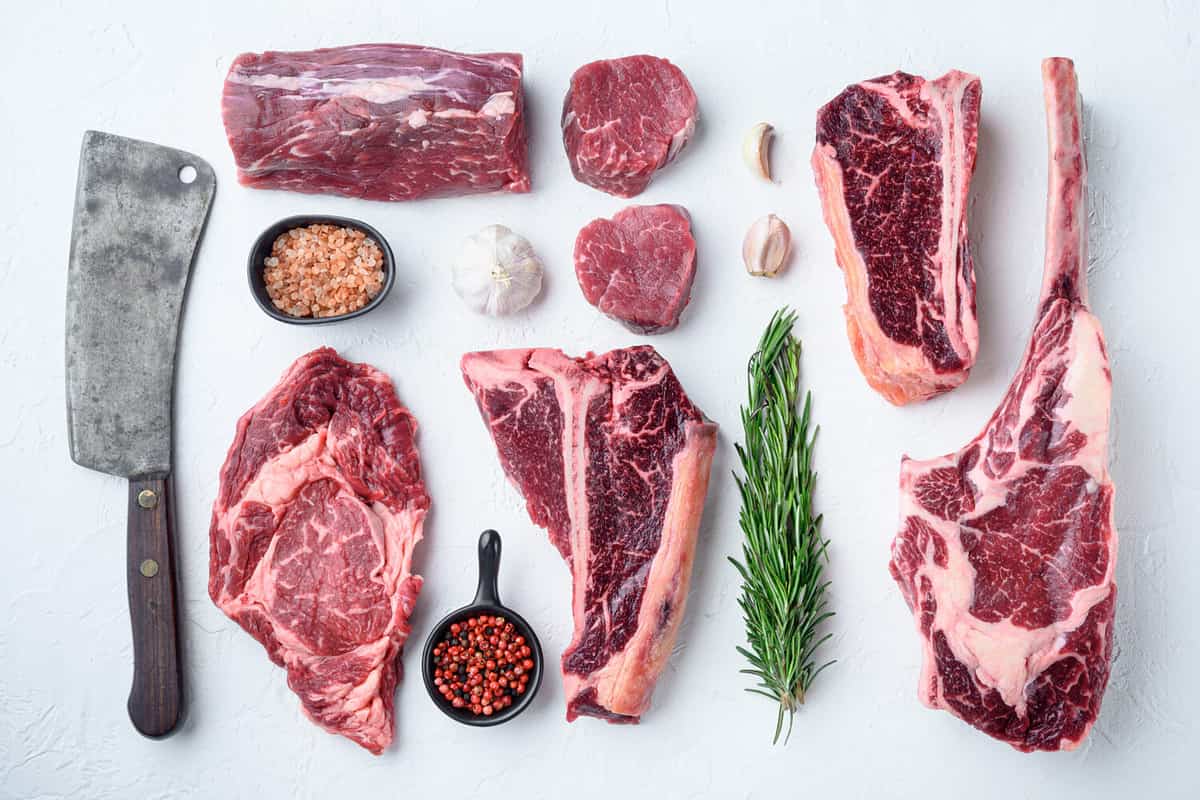
©Chatham172/Shutterstock.com
The primary difference between a New York strip and a sirloin steak is where they come from on a cow. The New York strip is cut from the short loin while the sirloin is cut from the back of the cow behind its ribs but before the rump. New York strips have tender texture, robust beef flavor, and rich marbling while sirloins have a more balanced flavor and firmer texture.
Sirloin cuts are generally leaner than New York strips, but can be divided between top sirloin (more tender) and bottom sirloin (more meat but less tender). The type of sirloin you purchase will generally dictate the cooking method.
Let's dive into the differences between these two cuts with particular emphasis on the marbling, flavor, and texture of both.
New York Strip vs Sirloin Nutritional Differences: Calories, Fat, and Protein
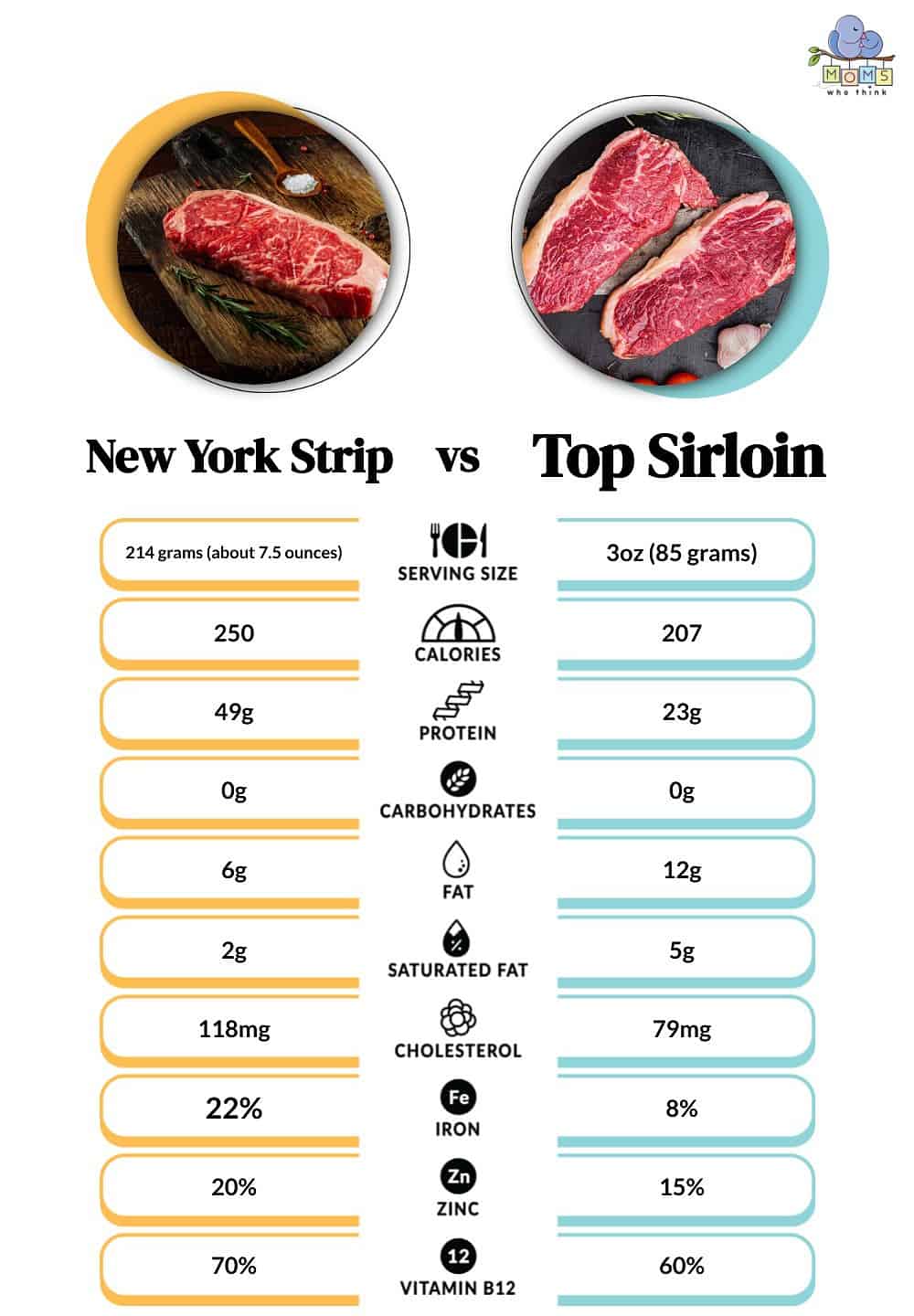
©
The data above comes directly from the USDA, but is probably for a particularly lean cut of New York strip as we were surprised at the calories, which on a per-ounce basis are less than top sirloin. In general, there isn't a huge difference in the nutritional differences of the steaks and the most important health aspect when eating either cut is portion control. Generally, the flat of your hand is equivalent to 3 to 4 ounces of meat.
What is Marbling?
First, let's take a look at what marbling is. When it comes to meat, marbling is an excellent indicator of juiciness. Marbling can be great for cooking, especially for beginner steak chefs, because the juiciness provides extra cooking oil. Therefore, the steak will have a less likely chance of becoming too well done too quickly and being chewy.
Marbling is excellent for these reasons:
- Intramuscular fat is a healthy fat.
- The more juiciness a steak has, the harder it would be to overcook.
- Marbling can mean it will be harder for the steak to become dry and tough.
It is important to note that juicy doesn't necessarily mean tender. There are plenty of cuts of meat with little marbling, but they still are tender and buttery. Marbling is an excellent indicator of how much juice and flavor will be provided while cooking. For example, the New York strip has more marbling than a sirloin. Meaning it is very flavorful. Often, the more marbling a steak has, the higher the meat's quality.
- The must-have convenient reference guide for every home cook!
- Includes more than 8,000 substitutions for ingredients, cookware, and techniques.
- Save time and money on by avoiding trips to grab that "missing" ingredient you don't really need.
What is New York Strip?
True to its name, the New York strip was first served in New York. The steakhouse that served it was Delmonico in 1837. The guests went crazy for it, and popularity rose. Today it is one of the most tender cuts of meat you can find in a steakhouse. However, it's also one of the more expensive ones.
New York strip comes from the short loin on the cow, the longissimus dorsi muscle. This muscle runs from the hip bone to the shoulder blade. So, because of the lack of exercise in this area, there's not much connective tissue or fat while the cow is alive. Also, this specific muscle does have beautiful marbling located throughout it. It provides a high-quality cut that is flavorful, tender, and almost melts in your mouth. So, because of the location, this muscle does not work much. Therefore, it makes the meat very tender. One of the contributing factors to the flavor of a steak is the marbling.
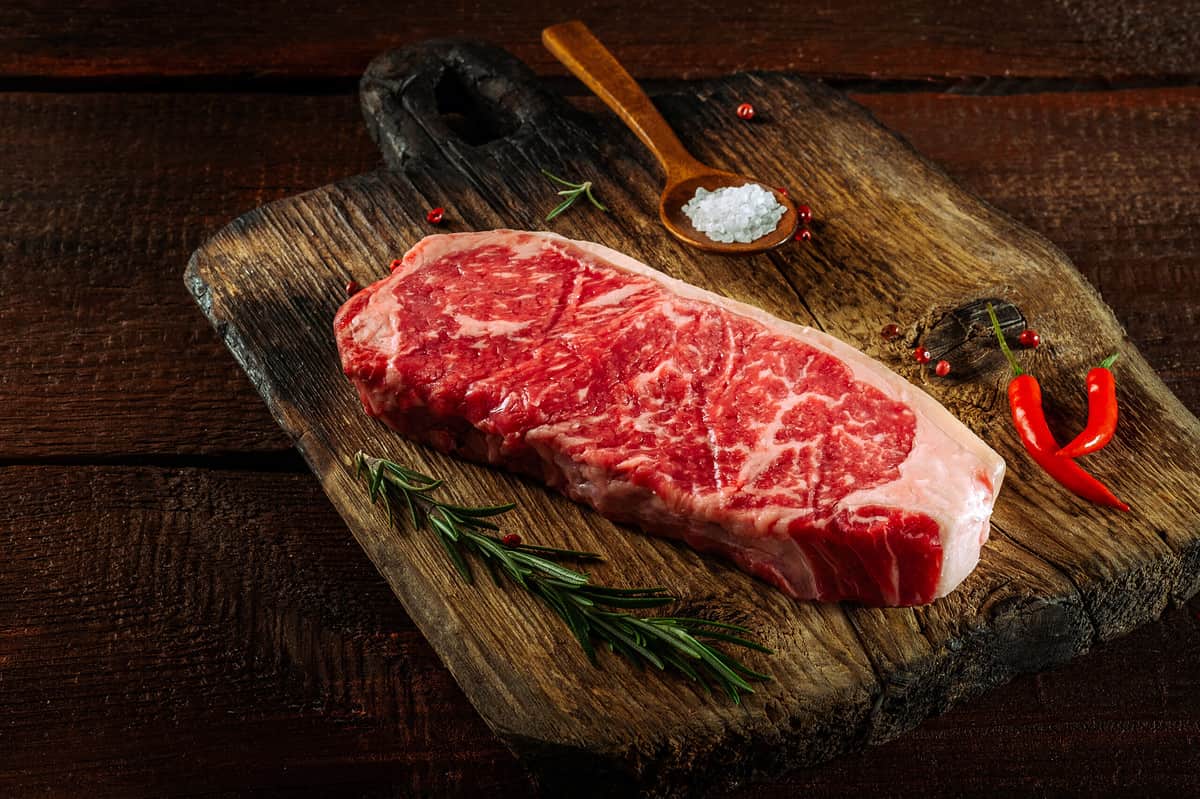
©Andrei Iakhniuk/Shutterstock.com
What is Sirloin?
The sirloin sits right between the short loin and the round on a cow. Therefore, the tenderness of sirloin is more moderate. This attribute is excellent for people looking for a beefy flavor that might be a little chewier than tender but does not feel like a leather shoe while eating it.
The sirloin is separated into two different sections. First, you have the top sirloin, which is great for steaks. So, that is where you get the term top sirloin from. Then the bottom sirloin is great for roasting. In addition, one of the main reasons this type of meat is prevalent among people who love steaks is because it is affordable, yet it still provides a juicy, beefy flavor that can still be tender. The marbling in a sirloin will vary depending on the animal. However, this cut tends to have less marbling than a New York strip. Also, it is not as high-quality of a cut as a New York strip, so it is less expensive.
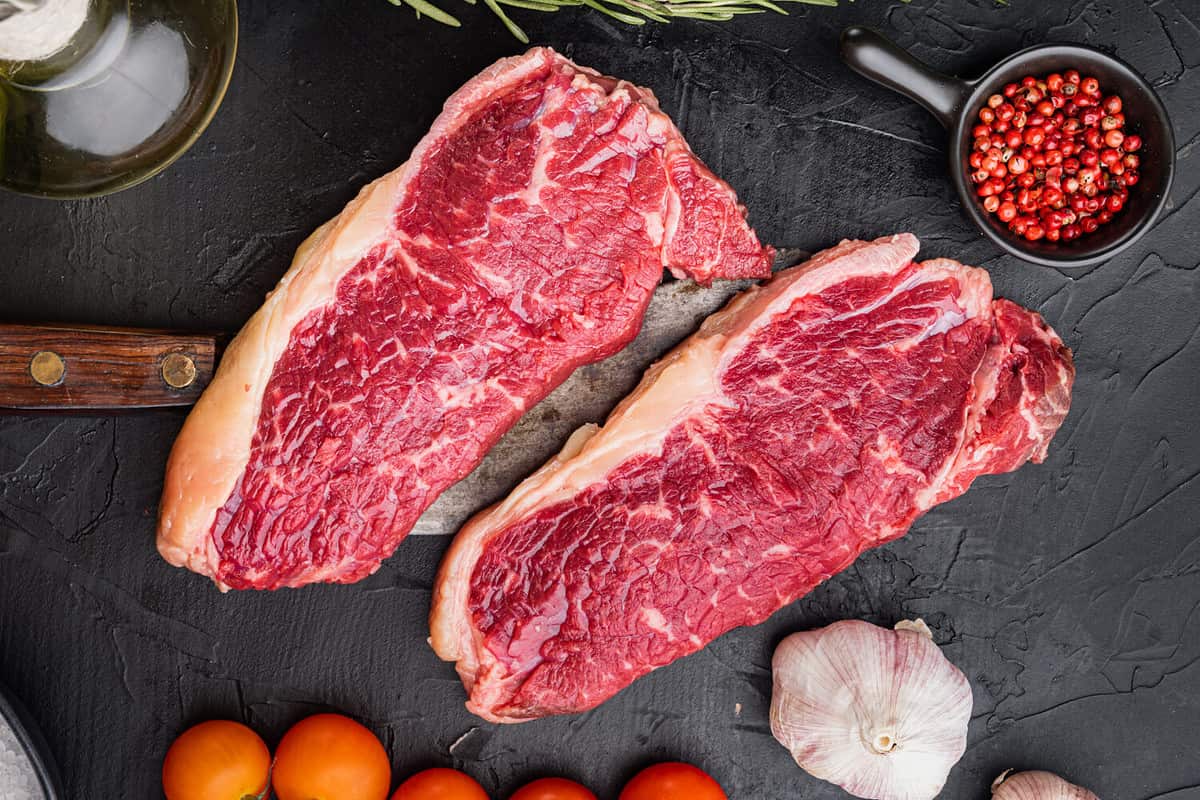
©Chatham172/Shutterstock.com
New York Strip vs. Sirloin: What Is the Difference?
So when we put these two cuts of meat next to each other, what are the differences? The New York strip is more tender because it is cut from the loin. The loin connects to the tenderloin, and this area of the cow tends to be one of the most tender areas. It is also important to note that you can keep a New York strip connected to the bone of the tenderloin, giving you a T-bone steak.
Another difference is that a New York strip is more expensive than a sirloin because of the cut and quality of the meat. Although sirloin tends to be less costly and less tender, it is still very popular among meat eaters. This is because it still produces a rich beefy flavor that steak lovers enjoy while not breaking the bank.
Sirloin averages around $11 a pound, depending on where you buy it. The New York strip averages around $15 per pound.
How to Cook Strip Steak
Let's take a look at a few of the ways to cook strip steak. Many enjoy cooking it on the grill or the stovetop with a cast-iron skillet. Broiling is another favorite way to cook this steak. When you are about to cook a New York strip steak, it is important to pull it out of the refrigerator and let it sit on the counter for at least 30 minutes so that it will reach room temperature.
Next, you will want to season it with salt and pepper. Also, remember, because of the rich flavor that strip steak has; it does not require a lot of seasoning. Next, heat your skillet with olive oil or butter when searing your steak. Sear your steak for one minute on each side. If you cook on the stovetop, you will want the internal temperature to reach 135° for medium rare. If you want medium doneness, it will need to reach 145°.
It is important to note that the grill will take longer to cook on than the stovetop. The steak typically takes 15 minutes or above to reach that perfect medium-rare doneness. After your steaks are done, you also want to give them 5 to 10 minutes of rest time. That way, they can continue to cook on the inside and reach the optimal temperature.
Cooking Methods for New York Strip
| Grilling | Pan-Frying | Oven | |
| Season steak with the desired seasoning. Preheat the grill. Set steaks out at room temperature for at least 30 minutes | Preheat a cast iron skillet. Set steaks out at room temperature for at least 30 minutes. Also, season the steak with pepper and salt. | Preheat oven to 275 degrees and set steaks at room temperature for at least 30 minutes. Season with your favorite season. | |
| Cook the steaks for four to five minutes on one side and flip. Cook for four to five minutes on the other side. | Cook on skillet for two to three minutes on each side. | Sear in a heated oven-safe skillet for two minutes per side. Place oven-safe skillet in the oven for up to seven minutes until the desired doneness. | |
| Rest for ten to 15 minutes. | Rest for ten to 15 minutes. | Allow steak to rest for ten to 15 minutes. | |
| Serve while hot. | Best served while hot. | Serve while hot. |
How to Cook Sirloin Steak
Sirloin steak is famous among meat lovers. People love to prepare it by grilling, pan-searing, or sticking it in the oven. If you are going to grill your sirloin steak, it will take around 25 minutes, depending on whether or not it's charcoal or a gas grill. Additionally, searing your sirloin steak may take approximately 15 minutes or less if you are pan-frying it. The oven typically takes around 25 minutes. Again if you want to reach rare-medium doneness, around 129° for a sirloin steak is optimal. 135° to. 145° is excellent for medium.
Another helpful tip for cooking your sirloin steak is to pound your steak with a meat mallet before you cook it to tenderize it. It can also be beneficial to marinate the steak in your favorite marinade. Finally, if you are pan-searing your steak, heat the pan with hot oil and then sear it on each side for two minutes, flipping around three to four times. This will take about 10 or 15 minutes of cook time on the stove.
Cooking Methods for Sirloin Steak
| Grilling | Pan Frying | Oven | |
| Set out for at least 30 minutes to reach room temperature. Season with your favorite seasoning. Start the grill. | Set out for at least 30 minutes to reach room temperature. Season with your favorite seasoning. Preheat the pan with oil until hot. | Set out for at least 30 minutes to reach room temperature. Season with your favorite seasoning. Preheat oven to 400 degrees. | |
| Cook the steaks on each side for at least six minutes to reach the desired doneness. The longer the steaks cook, the more done they will be. | Place the steaks with melted butter into the pan. Cook the steaks for three minutes on one side and flip. Cook the steaks for another three minutes with more butter added. Continue cooking until the desired doneness is reached. | Sear the steak on each side for two minutes in a heated pan. Place the oven-safe pan in the preheated oven for ten minutes. Check the doneness. Continue to cook until the desired doneness is reached. | |
| Rest for five minutes or more. | Allow steak to rest for five minutes or more. | Pull the steaks out and allow them to rest for five minutes or more. | |
| Serve while hot. | Best when served while hot. | Serve while hot. |
Doneness Temperature Guide
| Doneness Preference | Internal Temperature |
| Rare | 125 degrees |
| Medium Rare | 135 degrees |
| Medium | 145 degrees |
| Medium Well | 150 degrees |
| Well Done | 160 degrees |
Which Cut Is More Tender?
Out of these two cuts of meat, the clear winner of tenderness is the New York strip. It produces sought-after juiciness because of its beautiful marbling throughout the meat that steak lovers cannot get enough of. In addition, the New York strip gives an extraordinary tenderness that will melt in your mouth like butter and have your taste buds rejoicing. However, although the New York strip is the clear winner, sirloin can still be tender when cooked with great care. In addition, sirloin produces a rich, robust, delicious, beefy flavor.
- The must-have convenient reference guide for every home cook!
- Includes more than 8,000 substitutions for ingredients, cookware, and techniques.
- Save time and money on by avoiding trips to grab that "missing" ingredient you don't really need.
Appearance and Characteristic Differences
Here are the apparent appearance differences between the sirloin and the New York strip. The first one is that the New York strip has more marbling. Marbling is an excellent indicator of how easily you can cook the cut of meat. The more marbling your kind of meat has, the easier the cooking method will be because of the juice it provides. The sirloin is also a bit tougher to eat than the New York strip. That is because of its less marbling and the texture of the cut. Tenderness can also change depending on cooking methods.
Regarding appearance, the sirloin is a bit rounder than the New York strip. The New York strip is more of a strip of steak and is thinner.
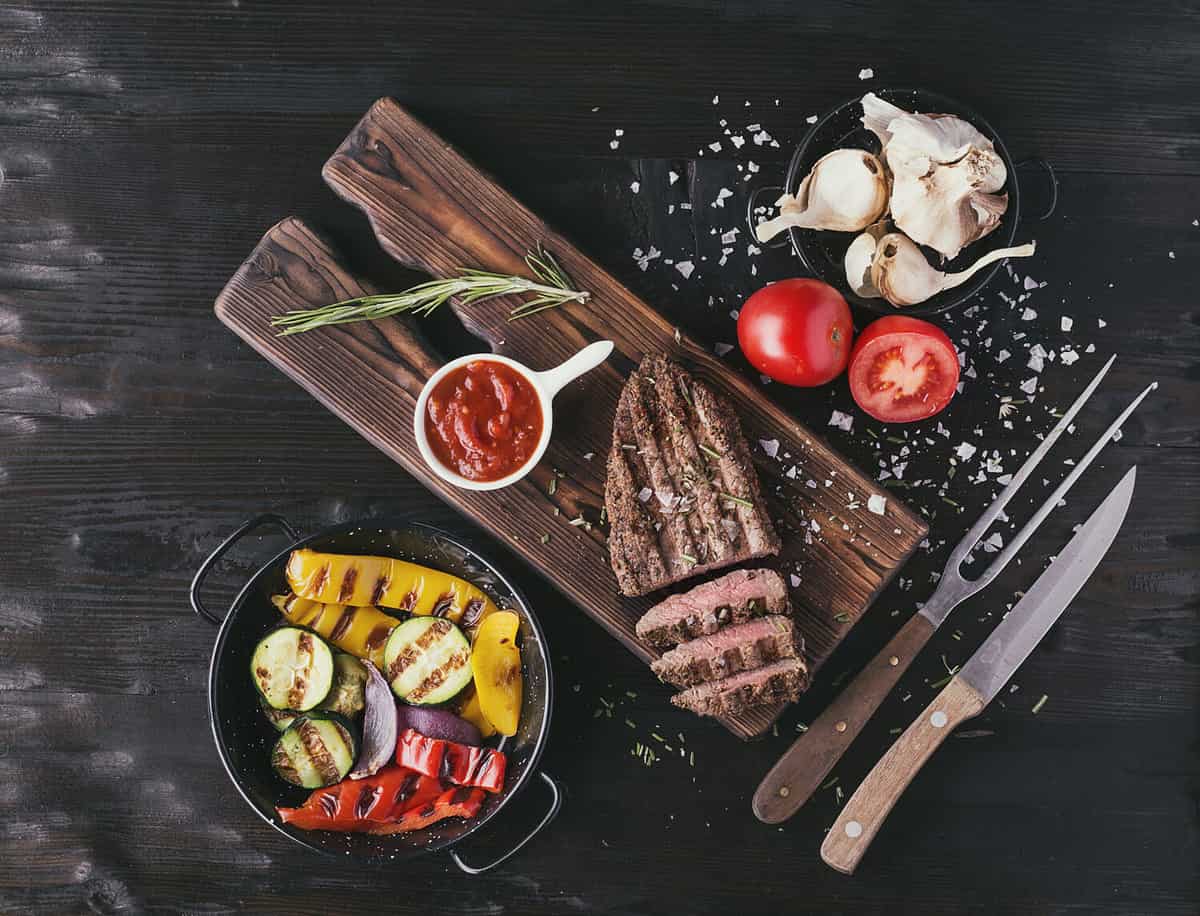
©Pedal to the Stock/Shutterstock.com
One Final Note
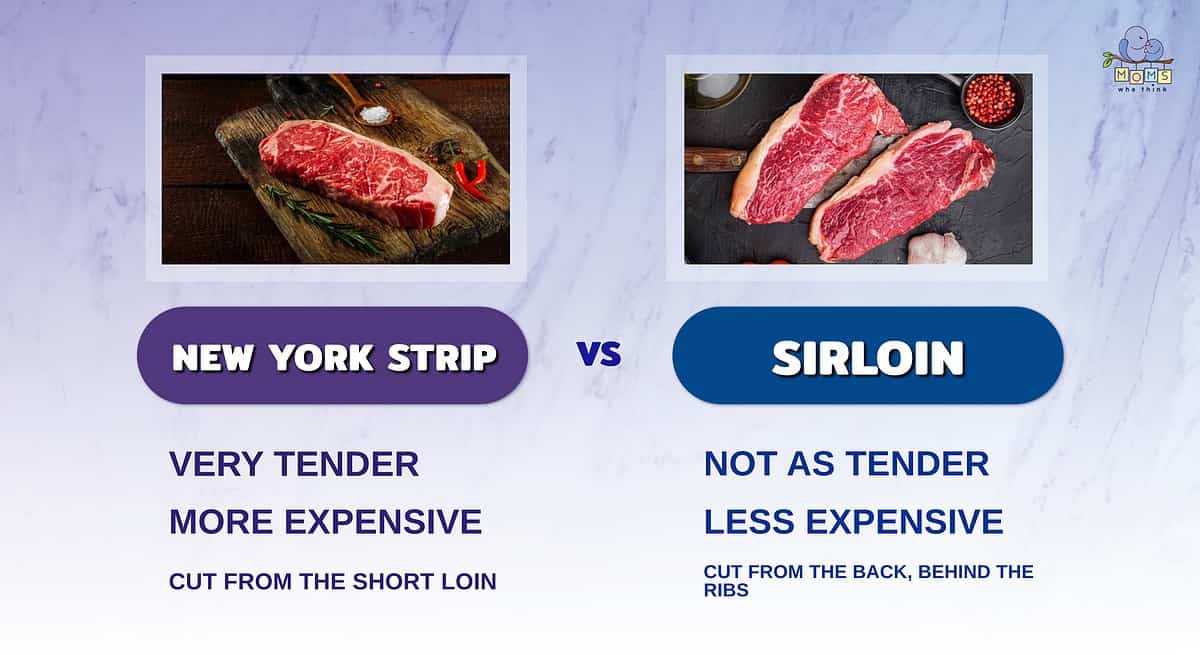
- New York strip is one of the most tender cuts of meat, with a smooth and buttery taste. Sirloin, when cooked properly, can still be tender. It tends to have a beefier, more robust taste than a New York strip.
- A sirloin is going to be cheaper than a New York strip steak, making it a better choice for those with a more limited budget.
- A New York strip is cut from the short loin of the cow, while the sirloin is cut from the back, behind the ribs.
If you are a steak lover, both sirloin and New York strip are delicious cuts of meat that will bring any dinner party together. However, if you are searching for the perfect steak, the truth is, it's all about personal preference. If you are looking for a tender, juicy steak that will melt in your mouth like butter, then the New York strip is the clear winner. However, the New York strip is more expensive than the top sirloin. Therefore, if you still want a steak that will be juicy and tender when prepared correctly and give you that rich beef flavor that so many steak lovers enjoy, then sirloin is an excellent choice. These steaks provide a delicious mouthwatering flavor that is quite hard to beat.
Steak Posts
- Sirloin vs. Strip Steak
- Prime Rib Vs. Steak: What's the Difference?
- Brisket vs. Steak: What's the Difference?
- London Broil vs. Flank Steak
- Flank Steak Vs. Round Steak
Steak Recipes
PrintBeef Sirloin with Fall Vegetables
- Yield: Serves 4
Ingredients
8 ounces parsnips, peeled and cut into 1/2-inch thick slices (2 to 3 medium)
8 ounces turnips, peeled and cut into 1/2-inch pieces (1 medium)
2 medium carrots, cut into 1/2-inch slices (1 cup)
12 ounces boneless beef sirloin, cut 1-inch thick
2 garlic cloves, minced
1 teaspoon dried thyme, crushed
1 teaspoon grated gingerroot
1/8 teaspoon pepper
Dash ground cloves
1/4 cup snipped chutney
Instructions
1. Place a steamer basket in a large saucepan with ½ inch water; heat to boiling. Add parsnips, turnips, and carrots to basket; cover and steam for 12 to 15 minutes or till vegetables are crisp-tender.
2. Meanwhile, cut meat into 4 serving-size pieces. Combine garlic, thyme, gingerroot, pepper, and cloves; rub over both sides of meat.
3. Place meat on the unheated rack of a broiler pan. Broil 3 to 4 inches from the heat for 8 to 12 minutes for rare or 13 to 17 minutes for medium doneness, turning meat once.
4. Discard the water for the vegetables and place vegetables in a bowl, add chutney, stirring to coat. Serve with the meat.
Nutrition
- Serving Size: Per serving
- Calories: 260
- Sodium: 101mg
- Fat: 8g
- Saturated Fat: 3g
- Carbohydrates: 27g
- Fiber: 6g
- Protein: 21g
- Cholesterol: 57mg
- Summer Barbecue Recipes: Burgers, Beans & Beyond
- Great Beef Recipes Using a Crock Pot
- Easy Swiss Steak Recipe
- Philly Steak Sandwiches Recipe
- Steaks and Burgers Recipes
